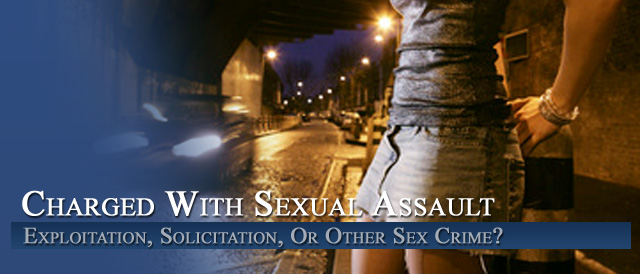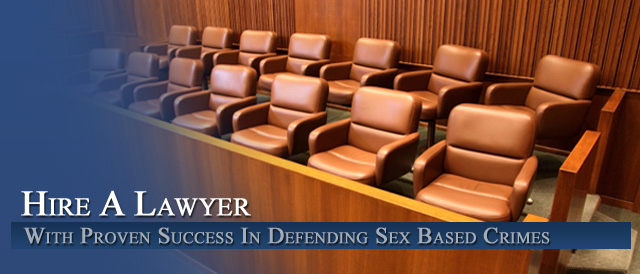




Colorado Juvenile Sex Offender Concepts – Understanding Why Juvenile Sex Crimes Are Different From Adult Sex Crimes
Introduction – The most frightening case for a parent is when their child is charged with a Colorado sexual offense. The important thing to understand in this situation is that the juvenile is treated in a very different way then their adult counterpart given charges that are identical. The juvenile is treated much less harshly – and the “no cure” model applied to the adult sex offender is NOT applied to the alleged juvenile. This page addresses some of the issues underlying those differences.
Understanding Colorado Juvenile Sex Offenders
As a Colorado criminal defense lawyer it has become clear that some children and teens sexually abuse others.
To fully understand how these children and teens are viewed in the context of the safety and well being of those around them, you must know some basic facts about juvenile sex offenders.
The following will give you a basic understanding of this troubled population.
Scope of the Problem
Research shows that sexual abuse of children is a widespread phenomenon. It is estimated that there are somewhere between 250,000 and 300,000 cases of child sexual abuse each year in the U.S. The estimated number of sex abuse survivors in the U.S. is over 60 million (NRCCSA, 1994).
Juvenile Sex Offenses
Although children and youth do engage in sexually aggressive and abusive behaviors, from a Colorado legal standpoint these offenses are not sexual abuse, even if they are committed against another child.
Exerts in the field agree that sexually abusive behavior—juvenile or otherwise—is contact that is sexual in nature and that occurs without consent, without equality, and as a result of coercion, manipulation, game-playing, or deception.
Sex offenses can include behaviors sometimes treated lightly, such as repeated obscene phone calls, exposure, frotteurism (rubbing against another against his or her will), and other forms of harassment. However, some adolescent offenses can be more serious, and the research shows that adolescents are actually more likely to attempt intercourse and other forms of genital/genital or genital/anal contact than are adult offenders.
The age of a perpetrator is not always the deciding factor in how law enforcement views these cases. Indecent exposure (flashing), touching over the clothes, obscene, pseudo-mature language, possession of pornography, and “boys-will-be-boys” type coercion may all be signs of an abuser or potential abuser.
Causes and Patterns of Unlawful Juvenile Sexual Behavior
There are a host of theories that have been proposed to explain why some children and teens sexually abuse others. Although there is no clear and simple formula for how this happens—sexual offending behaviors are extremely complex—the theory most widely accepted today is known as the “learning theory,” which holds that sexually abusive behavior in children is linked to many factors, including exposure to sexuality and/or violence, early childhood experiences (e.g., sexual victimization), exposure to child pornography and advertising, substance abuse, heightened arousal to children, and exposure to aggressive role models/family violence.
Early theories about children who sexually abuse others proposed that these individuals move through a predictable progression. In this cycle, an event causes a negative emotional response in the youth. The youth attempts to gain control of this response but fails. He then feels anger and rage, which in turn lead to thoughts of retaliation and fantasies of overpowering another, which lead to an assault..
More recently this cycle has been criticized as too rigid—interviews with offenders reveal that life problems (at school, in the family) and any number of thoughts or feelings can trigger an offending behavior.
Regardless of how they arise, over time offenses may escalate from “hands off” behaviors to more serious sexual assaults.
Traits of Offenders – Each Child Is Unique
A significant amount of research has been conducted on juvenile sex offenders. Although these efforts have revealed much solid information about this population, each of these children is unique. Perhaps the only statement that is reliably true for all juvenile sex offenders is that the traits and progression of behavior can vary tremendously from one individual to another.
That said, it is believed that we do know that nine of ten juvenile sex offenders are male), and that juvenile sex offenders often commit their first sexual offense before age 15 and even before age 12. It is also believed that juvenile sex offenders are found in every socioeconomic class and every racial, ethnic, religious, and cultural group.
Children who sexually abuse are more likely than the general population to have been physically, sexually, or otherwise abused. Studies indicate that between 40% and 80% of sexually abusive youth have themselves been sexually abused, and that 20% to 50% have been physically abused.
Some professionals believe a history of victimization is virtually universal among juvenile sex offenders. Experienced therapist Robert Longo writes, “As I think back to the thousands of sex offenders I have interviewed and the hundreds I have treated, I cannot think of many cases in which a patient didn’t have some history of abuse, neglect, family dysfunction, or some form of maltreatment within his or her history” (Longo, 2001).
According to the Center for Sex Offender Management (1999) the following are other common traits among juvenile sex offenders.
• Difficulties with impulse control and judgement
• High rates of learning disabilities and academic dysfunction (30% to 60%)
• Mental illness: up to 80% have a diagnosable psychiatric disorder
A minority of sexually abusive youth also have deviant sexual arousal and interest patterns.
“These arousal and interest patterns are recurrent and intense, and relate directly to the nature of the sexual behavior problem (e.g., sexual arousal to young children).”
Two Types of Offenders
Clinical observation and empirical research indicate that, as is the case for adult sexual offenders, juvenile sexual offenders fall into two groups:
1. Those who sexually abuse children
and
2. Those who victimize peers and adults.
These two groups, as reflected in the chart on the following page, have clear differences not only in the victims they select, but in their offense patterns, social and criminal histories, behavior patterns, and in the treatment they require.
Treatment
Since it was first identified as a serious problem, there have been tremendous advances in the treatments available for children and teens who sexually offend.
Treatment can be a difficult hurdle for juvenile sex offenders. In one study, as many as 50% of youths entering a community-based treatment program were expelled during the first year of participation, most often for failure to comply with attendance requirements or therapeutic directives .
This failure to complete treatment can increase a youth’s chances re-offending.
Recidivism – Repeating The Sex Crime and Escalation
A common belief about juvenile sexual offenders is that even after treatment, most will offend again. HOWEVER – citing the research literature, there is NO “no compelling evidence to suggest that the majority of juvenile sex offenders are likely to become adult sex offenders. . . . . juveniles who engage in sexual aggression frequently cease such behavior by the time they reach adulthood.”
Juveniles who participate in treatment programs have sexual recidivism rates that range between 7% and 13% over follow-up periods of two to five years. Research indicates that recidivism for nonsexual offenses is much higher among juveniles (25–50%) (Hunter, 2000).
Youths participating in treatment have lower recidivism rates than either adult sex offenders or untreated juvenile sex offenders. In an analysis of eight separate studies, Alexander (1999) found that while adults had re-offend rates that averaged 13%, juveniles who participated in offense-specific treatment had a recidivism rate that averaged 7.1% in a 3–5 year follow-up.
Worling (2001), in a large-scale study that examined data from across Canada, found that only 5% of youths who underwent treatment were charged with another sexual offense within six years, compared to 18% of the youths who did not participate in treatment (Ryan, 2000).
Sex Offending Behaviors in Juveniles
“Private parts” in the items below is taken to mean the genitals and genital areas, the area around the anus and buttocks, and the breasts of a female. It also should be noted that many (but not all) of the behaviors below would be considered sex offenses if they were engaged in by an adult.
Sexual Abuse
These behaviors qualify as sexual abuse:
Touching another’s private parts against that person’s will, either with hands, objects, or one’s own genitals—either with or without clothing on either person
Rape
Touching the private parts of a person significantly younger (e.g., a 13-year-old girl touching the genitals of an 8-year-old boy). When children close to the same age participate in consensual “exploration” – or other mock voluntary sexual activity, this may not be considered a sexual offense unless one of the children is unable to give or refuse consent (such as having a severe disability, being asleep, etc.)
Exposing self to another person without consent, or to a much younger child
Forcing another person to watch one masturbate
Repeated acts of voyeurism
Forcing another person to look at pornography, or showing pornography to a much younger child
Taking pornographic pictures of a child
May or May Not Be Sexual Abuse
These behaviors may or may not be considered sexual abuse—opinions vary—but they are serious and unusual enough to warrant attention – and the police and the DA will view each case individually.
The following behaviors may or may not be sex crimes:
Speaking to a younger child in an obscene fashion (sexualized language)
Public masturbation
Injuring the genitals of another person by kicking or hitting with an object
Kissing someone without consent, or kissing a much younger child
Other quasi-sexual touching of non-private areas
Cybersex or downloading pornography, especially “kiddie porn”
The following behaviors are considered to be warning signs warranting attention
These behaviors are not sexual abuse, but deserve attention:
Possession of large quantities of pornography, or use of pornography at an age before puberty
Early consensual sexual activity
Bragging about sex
Threats and intimidation of younger children
Close, friendly relationships with much younger children and a lack of friendships with peers
Frequent deceitfulness and lying
Physical abuse of others
Knowledge of sexuality unexpected for one’s age
(Sources: Fehrenbach et al., 1986; Johnson, 1988; Berliner, 1995)
Two Subgroups of Juvenile Sex Offenders
The following information originally appeared in Understanding Juvenile Sexual Offending Behavior: Emerging Research, Treatment Approaches and Management Practices, by the Center for Sex Offender Management.
Two Subgroups of Juvenile Sex Offenders
Traits Offend Against Peers or Adults Offend Against Children
Victims Predominantly assault females.
Assault mostly strangers or acquaintances.
Females victimized at slightly higher rates.
Nearly half assault at least one male.
Up to 40% of victims are either siblings or relatives.
Offense Patterns
More likely to commit offenses in conjunction with other criminal activity.
More likely to commit offenses in public areas.
Reliance on opportunity and guile, particularly when victim is a relative.
Trick child by using bribes or threatening loss of relationship.
Social and Criminal History
More likely to have histories of nonsexual criminal offenses.
Generally delinquent and conduct-disordered.
Deficits in self-esteem and social competency are common.
Often lack skills and attributes necessary for forming and maintaining healthy interpersonal relationships.
Behavior Patterns Display higher levels of aggression and violence.
More likely to use weapons and cause injuries to their victims.
Often display signs of depression.
Youths with severe personality and/or psychosexual disturbance may display high levels of aggression or violence.
Sex between Siblings
Children who have been molested often re-enact their abuse with other children. Therefore, when a child has committed sexual offenses against a sibling, it is important to assess whether the offending child has been sexually abused by an adult.
In cases of sexual activity between siblings, it is important to determine whether the behavior was normal childhood sex play or whether the older or stronger child was coercing, overpowering, intimidating, tricking, or manipulating a younger or smaller child.
Normal “sex play” occurs between young children of the same developmental level and power. (For more on normal sexual play in children, click here.)
Much incestuous behavior between siblings is considered to be more sexually abusive: the older child has more strength, more authority, and more experience (Gray & Pithers; Engel, 1994).
Normal Sexual Development
Infancy
Children begin to explore their bodies, including their genitals.
Skin touch is the primary method infants have available for learning about their bodies, other’s bodies, and their sexuality.
Other people’s response to that body exploration is one of the earliest forms of social learning.
Childhood
Half of all adults report having participated in sex play as children.
Children express interest in feelings aroused by touching their genitalia in the same way they express interest in the light of the moon, or a flower blooming.
Children express general interest in others’ bodies and may touch. Adult reactions teach shame or that privacy is important for certain behaviors.
Masturbation occurs naturally in boys and girls, and begins in infancy.
By the age of two or three years, most children have learned that masturbation in front of others is likely to get them in trouble.
Pre-Adolescence
A strong interest in viewing (via photographs, films, videos, etc.) other people’s bodies.
Very few children become sexually active in pre-adolescence. When they do, it is usually initiated by adults.
Sexual activity or play during this age usually represents the use of sex for non-sexual goals and purposes.
Adolescence
Adolescence itself is generally marked by the societal acknowledgment of sexual capacity. The way other people react to a teen’s physical sexual characteristics (body hair, formation of breasts, deepening of the voice, beginning of menses) have a profound affect on both the young person’s sense of self esteem and the development of his/her social skills.
The adolescent develops a growing awareness of being a sexual person, and of the place and value of sex in one’s life, including such options as celibacy.
The adolescent may work toward significant resolution of confusion and conflict about sexual orientation.
It is during this time that individuals are able to join together the physical and social aspects of sex and sexuality.
Most adolescents practice some types of interactive sexual behaviors with others, such as fondling, open-mouth kissing, and simulated intercourse.
The Course of Treatment
Clinical programming for sexually abusive youth typically includes a combination of individual, group, and family therapies. In addition, many programs offer supportive educational groups to families of these youth. Juveniles who display more extensive psychiatric or behavioral problems, such as substance abuse, may require additional treatment, including drug and alcohol rehabilitation and psychiatric care.
All therapies provided to sexually abusive youth should be carefully coordinated within the treatment agency and with external agencies providing case management and oversight. Treatment programs need to be individually tailored through a thorough assessment of the youth, family, and environment.
Providers have established the following as essential components of the treatment process:
Gaining control of behavior.
Teaching the impulse control and coping skills needed to successfully manage sexual and aggressive impulses.
Teaching assertiveness skills and conflict resolution skills to manage anger and resolve interpersonal disputes.
Enhancing social skills to promote greater self-confidence and social competency.
Programming designed to enhance empathy and promote a greater appreciation for the negative impact of sexual abuse on victims and their families.
Provisions for relapse prevention. This includes teaching youths to understand the cycle of thoughts, feelings, and events that are antecedent to the sexual acting-out, identify environmental circumstances and thinking patterns that should be avoided because of increased risk of reoffending, and identify and practice coping and self-control skills necessary for successful behavior management.
Establishing positive self-esteem and pride in one’s cultural heritage.
Teaching and clarifying values related to respect for self and others, and a commitment to stop interpersonal violence. The most effective programs promote a sense of healthy identity, mutual respect in male-female relationships, and a respect for cultural diversity.
Providing sex education to give an understanding of healthy sexual behavior and to correct distorted or erroneous beliefs about sexual behavior.
Adapted from: Simon, W., & Gagnon, J. (1998). Psychosexual development. Society, 35 (2), 60-68. Sgroi, S., Bunk, B., & Wabrek, C. (1988). Children’s sexual behaviors and their relationship to sexual abuse. In A. Gitterman (Ed.), Vulnerable Populations. Lexington, MA: Lexington Books. Sarrel, L. (1989). Sexual unfolding revisited. SIECUS Report, 18 (1), 4-5.
For additional information on juvenile sex offenders, see this source yourself at THIS LINK
Other Articles of Interest:
- Colorado Juvenile Sex Offender Case Issues
- Understanding the Juvenile Sex Offender and Treatment Modalities in Colorado
- Colorado Juvenile Sex Offender Registration Requirements -The Federal Sex Offender Registration and Notification Act – SORNA
- Colorado Criminal Law: The Statute of Limitations on Sex Crimes – The Role of DNA
- Understanding Colorado’s Sex Offender Risk Scales – Sex Offender Evaluations












